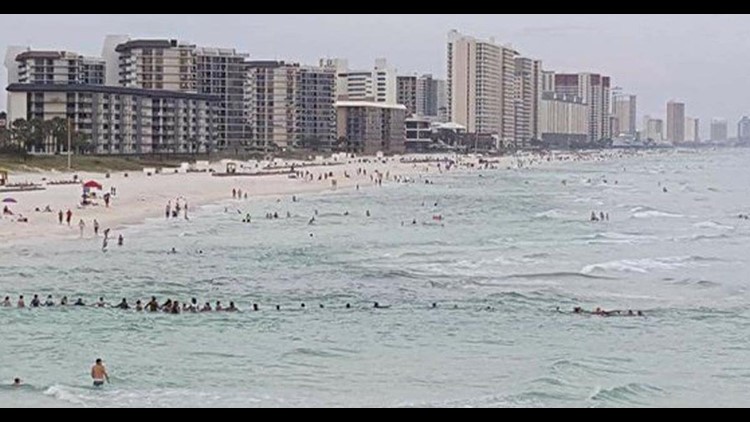PANAMA CITY BEACH, Fla. — An Alabama woman and her husband started a human chain and helped rescue an entire family of nine caught in a riptide off the coast of Florida.
Jessica Simmons and her husband, Derek, were standing on a pier off the coast of Panama City Beach Saturday afternoon, WSFA reports. That’s when they heard a commotion and saw people pointing at two boys who had become caught in a riptide.
Noticing what was happening, the boys’ mother, Roberta Ursrey, and her husband, nephews, mother and two daughters tried to swim out and rescue them.
“At first, you’d think it was a shark. You know, everyone’s pointing,” Derek said. “So we kept walking, and when we got over there, there was a guy in the water, saying, ‘man, they’re all stuck out there, the riptide’s pulled them out, I tried to go out there; if I go any farther, I’m going to get stuck.'”
That’s when the couple started a human chain in an attempt to reach the family and pull them to safety.
The chain grew from five to 15 people and continued to expand until it grew to more than 80 people and was 100 yards long, according to The Panama City News Herald. The chain eventually reached the family and was able to pull them all to safety.
“Without them, we wouldn’t be here, because emergency personnel stood on the beach,” Ursrey said. “They wouldn’t even link up and help. It was the human chain that pulled us out of that water. God’s good grace and them is the reason we’re here today.”
“Rip currents are channelized currents of water flowing away from shore at surf beaches. Typically, they form at breaks in sandbars, and also near structures, such as jetties and piers, as well as cliffs that jut into the water. Rip currents are common and can be found on most surf beaches, including the Great Lakes and Gulf of Mexico. Take a few minutes to learn more or check out the Science of the Surf site.”
“Don’t fight the current. It’s a natural treadmill that travels an average speed of 1-2 feet per second, but has been measured as fast as 8 feet per second—faster than an Olympic swimmer. Relax and float to conserve energy. Staying calm may save your life. Do NOT try to swim directly into to shore. Swim along the shoreline until you escape the current’s pull. When free from the pull of the current, swim at an angle away from the current toward shore. If you feel you can’t reach shore, relax, face the shore, and call or wave for help. Remember: If in doubt, don’t go out!”



